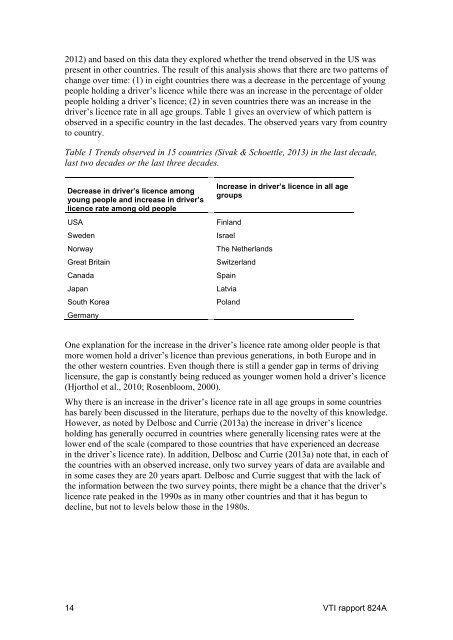utvecklingen-av-korkortsinnehav-bland-unga-mojliga-forklaringar-konsekvenser-och-trender
utvecklingen-av-korkortsinnehav-bland-unga-mojliga-forklaringar-konsekvenser-och-trender
utvecklingen-av-korkortsinnehav-bland-unga-mojliga-forklaringar-konsekvenser-och-trender
You also want an ePaper? Increase the reach of your titles
YUMPU automatically turns print PDFs into web optimized ePapers that Google loves.
2012) and based on this data they explored whether the trend observed in the US waspresent in other countries. The result of this analysis shows that there are two patterns ofchange over time: (1) in eight countries there was a decrease in the percentage of youngpeople holding a driver’s licence while there was an increase in the percentage of olderpeople holding a driver’s licence; (2) in seven countries there was an increase in thedriver’s licence rate in all age groups. Table 1 gives an overview of which pattern isobserved in a specific country in the last decades. The observed years vary from countryto country.Table 1 Trends observed in 15 countries (Sivak & Schoettle, 2013) in the last decade,last two decades or the last three decades.Decrease in driver’s licence amongyoung people and increase in driver’slicence rate among old peopleUSASwedenNorwayGreat BritainCanadaJapanSouth KoreaGermanyIncrease in driver’s licence in all agegroupsFinlandIsraelThe NetherlandsSwitzerlandSpainLatviaPolandOne explanation for the increase in the driver’s licence rate among older people is thatmore women hold a driver’s licence than previous generations, in both Europe and inthe other western countries. Even though there is still a gender gap in terms of drivinglicensure, the gap is constantly being reduced as younger women hold a driver’s licence(Hjorthol et al., 2010; Rosenbloom, 2000).Why there is an increase in the driver’s licence rate in all age groups in some countrieshas barely been discussed in the literature, perhaps due to the novelty of this knowledge.However, as noted by Delbosc and Currie (2013a) the increase in driver’s licenceholding has generally occurred in countries where generally licensing rates were at thelower end of the scale (compared to those countries that h<strong>av</strong>e experienced an decreasein the driver’s licence rate). In addition, Delbosc and Currie (2013a) note that, in each ofthe countries with an observed increase, only two survey years of data are <strong>av</strong>ailable andin some cases they are 20 years apart. Delbosc and Currie suggest that with the lack ofthe information between the two survey points, there might be a chance that the driver’slicence rate peaked in the 1990s as in many other countries and that it has begun todecline, but not to levels below those in the 1980s.14 VTI rapport 824A


